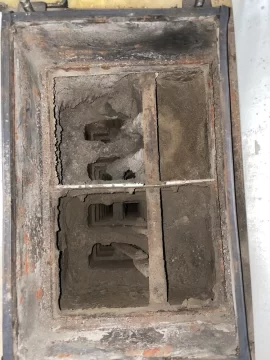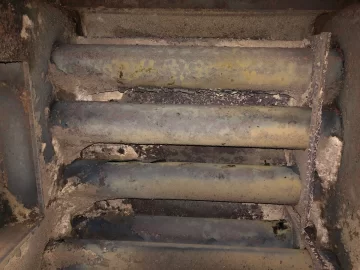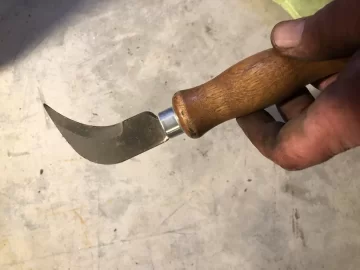I just bought a house with a Harman PB 105 pellet boiler, and I'm getting it ready for the winter heating season. I figure I should start by cleaning/inspecting everything. I'm supposed to clean the tube heat exchangers once per week, but when I go to remove them, they're stuck fast. From the one video I found dealing with PB 105 maintenance, I see these should just slip out easily. I don't think I'm supposed to use a wrench on the bolts, am I? Any assistance appreciated! Thanks.
Harman PB 105: Getting the heat exchanger cleanout rods out?
- Thread starter JeffinVermont
- Start date
-
Active since 1995, Hearth.com is THE place on the internet for free information and advice about wood stoves, pellet stoves and other energy saving equipment.
We strive to provide opinions, articles, discussions and history related to Hearth Products and in a more general sense, energy issues.
We promote the EFFICIENT, RESPONSIBLE, CLEAN and SAFE use of all fuels, whether renewable or fossil.
You are using an out of date browser. It may not display this or other websites correctly.
You should upgrade or use an alternative browser.
You should upgrade or use an alternative browser.
PassionForFire&Water
Minister of Fire
They are probably stuck near the bottom because of creosote and ash particles binding togetter during the time it did not operate.
You will need to get them out anyhow.
I don't know this machine, but I have used a #4 or #5 piece of rebar to pound tubulators down or disconnect the motor and use a mexhanical lever to get them moving.
They will probably be damaged after the operation, then you will need to find replacements.
Without them you will loose to much heat up the stack.
Is there any access via the bottom?
Can you post some pictures or a video of this?
Below picture/video of how a pellet boilertubulators looks like after not cleaning of 4 or 5 years.
Pictures are not from the same boiler

You will need to get them out anyhow.
I don't know this machine, but I have used a #4 or #5 piece of rebar to pound tubulators down or disconnect the motor and use a mexhanical lever to get them moving.
They will probably be damaged after the operation, then you will need to find replacements.
Without them you will loose to much heat up the stack.
Is there any access via the bottom?
Can you post some pictures or a video of this?
Below picture/video of how a pellet boilertubulators looks like after not cleaning of 4 or 5 years.
Pictures are not from the same boiler

Attachments
Thanks for the reply. In the interim, we thought to call the folks that installed it back in 2008, and they provided super-helpful advice over the phone to us. They suggested we fire it up, and that the heat might loosen the rods enough to remove them. I'll be trying that this morning. Our boiler doesn't have the mechanisms you show in your videos. The rods just sit in there soaking up the heat. The only moving part is the auger that feeds the pellets into the burn chamber. When I head down, I'll take some photos to post and will update the thread to add to the knowledge base. Thanks again,
Jeff
Jeff
And here's a photo of the innards, for what it's worth. We did get the boiler going and it seemed to be doing pretty well until we found a quart or two of water over the floor. The dealer thinks its a faulty pressure relief valve (since the pressure seemed to be in normal operating range, about 10 psi). The theory about the heat loosening up the rods hasn't proved valid yet.Thanks for the reply. In the interim, we thought to call the folks that installed it back in 2008, and they provided super-helpful advice over the phone to us. They suggested we fire it up, and that the heat might loosen the rods enough to remove them. I'll be trying that this morning. Our boiler doesn't have the mechanisms you show in your videos. The rods just sit in there soaking up the heat. The only moving part is the auger that feeds the pellets into the burn chamber. When I head down, I'll take some photos to post and will update the thread to add to the knowledge base. Thanks again,
Jeff

salecker
Minister of Fire
Try putting a couple cut up raw potatoes in the gasification chamber when it's running.
I read that it helps break down creosote.
I read that it helps break down creosote.
Mr._Graybeard
Feeling the Heat
The heat exchanger tubes are badly choked with creosote and ash. It probably was run at too low a temperature, which produces condensation and creosote. The temp of the water jacket should not drop below 140F when it's burning. Keep it hot and it will stay clean.
You might try heating the plates that scrape the tubes with a heat gun or propane torch to melt the goo. Creosote can be corrosive, so having that kind of buildup is very bad for the unit.
Last spring the blanking plate for the hot water coil started leaking on my boiler. A new gasket solved the problem.
You might try heating the plates that scrape the tubes with a heat gun or propane torch to melt the goo. Creosote can be corrosive, so having that kind of buildup is very bad for the unit.
Last spring the blanking plate for the hot water coil started leaking on my boiler. A new gasket solved the problem.
Mr._Graybeard
Feeling the Heat
One more thought -- the rods can seize up in the bushings where they pass through the wall of the boiler, A little penetrating oil should loosen them up.
Thanks.....this last one sounds like the best first response before I move on to the others. I'll give it a try. Some WD40 worked to loosen the wingnuts that held on the cleanout door to the burn chamber. If not, I'll move on to the others, but I will adm"it that it's hard for me to tell what's going on in there. When you say, "You might try heating the plates that scrape the tubes with a heat gun or propane torch to melt the goo"....I'm not sure what "the plates that scrape the tubes" are. It's unclear to me what actually happens when (if) I get those rods to pull out. The Harman manual isn't very illuminating about that.One more thought -- the rods can seize up in the bushings where they pass through the wall of the boiler, A little penetrating oil should loosen them up.
Jeff
Well....I did have a good time reading the discussion of this on this forum from about 11 years ago. The owners manual is pretty clear about not putting anything but the pellets in, so I may pass on this one.Try putting a couple cut up raw potatoes in the gasification chamber when it's running.
I read that it helps break down creosote.
Mr._Graybeard
Feeling the Heat
The rods are attached to vertical plates that slide over the heat exchanger tubes to scrape off loose ash. Looking at the photo you uploaded, you can see one of the plates on the right side of the vertical heat exchanger tubes.
I agree that the first thing I'd do is lube up the bushings that the rods pass through. Creosote and ash as well as rust can gum them up. I try to use some kind of heavier lubricant on the rods at the end of each heating season so they don't get stuck over the summer.
In the photo, you can see the range of travel the scraper plates have by the large buildup at each end of the heat exchanger tubes. The scrapers are something you should use every day or two, but the boiler requires that you go in and clean off the stuff the scrapers miss every month or so. I usually run a wire brush over the interior walls of the boiler and (very important) clean off the combustion fan blades, the backing plate and the chamber the fan sits in about every six weeks or two tons of pellets (I burn hardwoods). Keep that combustion fan area clean and you'll enjoy the boiler a lot more.
Do you know if your boiler has a finned igniter or the later pressure igniter? If it's a 2008, I'd suspect it's the former.
We have a number of PB105 users here, many of whom are likely to come online once the heating season comes into full swing. From Harman's perspective it was probably a failure because of the cost, but it's really a fine machine. Kind of a Cadillac or Lincoln vs. the Euro boilers' BMW or Mercedes.
I agree that the first thing I'd do is lube up the bushings that the rods pass through. Creosote and ash as well as rust can gum them up. I try to use some kind of heavier lubricant on the rods at the end of each heating season so they don't get stuck over the summer.
In the photo, you can see the range of travel the scraper plates have by the large buildup at each end of the heat exchanger tubes. The scrapers are something you should use every day or two, but the boiler requires that you go in and clean off the stuff the scrapers miss every month or so. I usually run a wire brush over the interior walls of the boiler and (very important) clean off the combustion fan blades, the backing plate and the chamber the fan sits in about every six weeks or two tons of pellets (I burn hardwoods). Keep that combustion fan area clean and you'll enjoy the boiler a lot more.
Do you know if your boiler has a finned igniter or the later pressure igniter? If it's a 2008, I'd suspect it's the former.
We have a number of PB105 users here, many of whom are likely to come online once the heating season comes into full swing. From Harman's perspective it was probably a failure because of the cost, but it's really a fine machine. Kind of a Cadillac or Lincoln vs. the Euro boilers' BMW or Mercedes.
Thanks for the good advice. Here's an update:The rods are attached to vertical plates that slide over the heat exchanger tubes to scrape off loose ash. Looking at the photo you uploaded, you can see one of the plates on the right side of the vertical heat exchanger tubes.
I agree that the first thing I'd do is lube up the bushings that the rods pass through. Creosote and ash as well as rust can gum them up. I try to use some kind of heavier lubricant on the rods at the end of each heating season so they don't get stuck over the summer.
In the photo, you can see the range of travel the scraper plates have by the large buildup at each end of the heat exchanger tubes. The scrapers are something you should use every day or two, but the boiler requires that you go in and clean off the stuff the scrapers miss every month or so. I usually run a wire brush over the interior walls of the boiler and (very important) clean off the combustion fan blades, the backing plate and the chamber the fan sits in about every six weeks or two tons of pellets (I burn hardwoods). Keep that combustion fan area clean and you'll enjoy the boiler a lot more.
Do you know if your boiler has a finned igniter or the later pressure igniter? If it's a 2008, I'd suspect it's the former.
We have a number of PB105 users here, many of whom are likely to come online once the heating season comes into full swing. From Harman's perspective it was probably a failure because of the cost, but it's really a fine machine. Kind of a Cadillac or Lincoln vs. the Euro boilers' BMW or Mercedes.
- I've had success freeing the rods, understanding how they work and cleaning the innards. The rods came free with a couple of doses of WD40 followed by some bangs from a plastic mallet. When they came free, I could see how they cause the scraper plates to move. I've posted a video below for anyone getting to this thread from the internet with the same questions as me. Plus, the previous owner left the curved tool (see picture) that PERFECTLY fits over the exchanger tubes. That, plus a wire brush and vacuum got them pretty clean. I also cleaned out the combustion fan.
- Advice to other newbies: an N95 mask with a respirator made this task more comfortable. There was a lot of fine ash. Also, setting up some good lighting inside the box was a big help.
- I had a plumber come to replace the pressure relief valve, the expansion tank, and the temperature/pressure gauge.
- I fired up the boiler this morning and it worked great!
- Interestingly, I now have strange behavior in a couple of the thermostat zones. I have five zones. One is in my garage workroom that has an industrial looking fan hanging from the ceiling. Prior to this, I couldn't get the zone to respond with heat. After firing up the pellet boiler, though, this zone came alive. And wouldn't turn off even after I turned down the thermostat. When I shut down the pellet boiler later in the day, the garage zone turned down. I'll likely bring in someone that can deal with the oil burner/pellet burner system to take a look. But overall, the system is ready to go--ready to burn the two tons we had delivered last week.
Jeff

Attachments
Interesting “tool.” It sure looks like a linoleum knife to me. 😂Neccesity is the mother of invention, or perhaps we should say the mother of repurposing here. 👍🏾Plus, the previous owner left the curved tool (see picture) that PERFECTLY fits over the exchanger tubes.
Mr._Graybeard
Feeling the Heat
When you clean your burn chamber, turn the feed dial to "test." that will run the combustion blower and create a draft so the airborne ash doesn't fly in your face. As long as you have the burn chamber door open the auger's "test" function will not operate but the blower motor will run.
Similar threads
- Replies
- 23
- Views
- 3K
- Replies
- 3
- Views
- 629
- Replies
- 0
- Views
- 546
- Replies
- 10
- Views
- 1K

